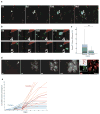Dynamic single-cell imaging of direct reprogramming reveals an early specifying event
- PMID: 20436460
- PMCID: PMC2908494
- DOI: 10.1038/nbt.1632
Dynamic single-cell imaging of direct reprogramming reveals an early specifying event
Abstract
The study of induced pluripotency often relies on experimental approaches that average measurements across a large population of cells, the majority of which do not become pluripotent. Here we used high-resolution, time-lapse imaging to trace the reprogramming process over 2 weeks from single mouse embryonic fibroblasts (MEFs) to pluripotency factor-positive colonies. This enabled us to calculate a normalized cell-of-origin reprogramming efficiency that takes into account only the initial MEFs that respond to form reprogrammed colonies rather than the larger number of final colonies. Furthermore, this retrospective analysis revealed that successfully reprogramming cells undergo a rapid shift in their proliferative rate that coincides with a reduction in cellular area. This event occurs as early as the first cell division and with similar kinetics in all cells that form induced pluripotent stem (iPS) cell colonies. These data contribute to the theoretical modeling of reprogramming and suggest that certain parts of the reprogramming process follow defined rather than stochastic steps.
Figures




Comment in
- Regen Med. 2010 Jul;5(4):501-3
References
-
- Takahashi K, Yamanaka S. Induction of pluripotent stem cells from mouse embryonic and adult fibroblast cultures by defined factors. Cell. 2006;126:663–676. - PubMed
-
- Nakagawa M, et al. Generation of induced pluripotent stem cells without Myc from mouse and human fibroblasts. Nat Biotechnol. 2008;26:101–106. - PubMed
-
- Wernig M, Meissner A, Cassady JP, Jaenisch R. C-Myc is dispensable for direct reprogramming of mouse fibroblasts. Cell stem cell. 2007 - PubMed
-
- Yu J, et al. Induced pluripotent stem cell lines derived from human somatic cells. Science. 2007;318:1917–1920. - PubMed
-
- Feng B, et al. Reprogramming of fibroblasts into induced pluripotent stem cells with orphan nuclear receptor Esrrb. Nat Cell Biol. 2009;11:197–203. - PubMed
Publication types
MeSH terms
Substances
Associated data
- Actions
Grants and funding
LinkOut - more resources
Full Text Sources
Other Literature Sources
Molecular Biology Databases

